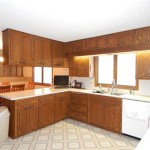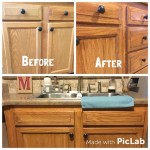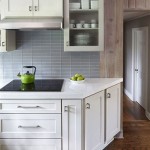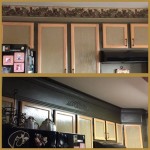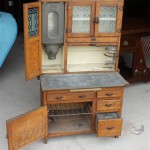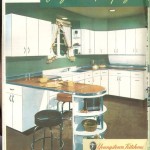Painting Old Kitchen Cabinets: A Comprehensive Guide
Painting old kitchen cabinets is a cost-effective and transformative way to refresh a kitchen’s aesthetic without undertaking a full renovation. It allows homeowners to update the style, color, and overall feel of their kitchen space, breathing new life into what might otherwise appear dated or worn. The process, while manageable, requires careful planning, meticulous preparation, and proper application techniques to achieve a durable and professional-looking finish.
This guide outlines the essential steps involved in painting old kitchen cabinets, providing detailed instructions and addressing potential challenges. From choosing the right materials to ensuring proper surface preparation and applying multiple coats of paint, this article offers a comprehensive overview of the process, enabling individuals to achieve a high-quality and lasting transformation of their kitchen space.
Key Point 1: Preparation is Paramount
The success of any painting project hinges significantly on the quality of the preparation. Neglecting proper surface preparation can lead to a variety of issues, including poor adhesion, an uneven finish, and premature wear and tear. This section details the necessary steps to thoroughly prepare old kitchen cabinets for painting.
1. Removal of Hardware: The first step involves removing all hardware, including knobs, pulls, hinges, and any other attached elements. This allows for easier access to all surfaces and ensures a clean, unobstructed painting process. Store the hardware in labeled bags to facilitate easy reinstallation later. If you plan to replace the hardware, now is the ideal time to select and purchase new pieces.
2. Deep Cleaning: Kitchen cabinets accumulate grease, dirt, and grime over time. Thorough cleaning is essential for proper paint adhesion. Use a degreasing cleaner specifically designed for kitchen surfaces. Apply the cleaner according to the manufacturer’s instructions, paying particular attention to areas around handles and hinges, which tend to accumulate the most residue. Rinse thoroughly with clean water and allow the cabinets to dry completely.
3. Surface Repair: Inspect the cabinets for any damage, such as cracks, dents, or scratches. Repair imperfections using wood filler or putty. Apply the filler to the damaged areas, allow it to dry completely, and then sand it smooth to blend seamlessly with the surrounding surface. For larger areas of damage, multiple applications of filler may be necessary, with sanding performed after each application.
4. Sanding: Sanding is a crucial step in preparing the cabinets for painting. It creates a slightly roughened surface, which promotes better adhesion of the primer and paint. Use a medium-grit sandpaper (around 120-grit) to lightly sand the entire surface of the cabinets. Focus on areas that are glossy or have a smooth finish. After sanding, use a fine-grit sandpaper (around 220-grit) to smooth out any rough patches. Remove all sanding dust with a tack cloth or a vacuum cleaner equipped with a brush attachment.
5. Priming: Applying a primer is essential for several reasons. Primer seals the surface, prevents the paint from being absorbed into the wood, and provides a uniform base for the paint to adhere to. Choose a high-quality primer specifically designed for use on wood or laminate surfaces. Apply the primer in thin, even coats using a brush, roller, or sprayer. Allow the primer to dry completely according to the manufacturer’s instructions before proceeding to the next step. Lightly sand the primed surface with a fine-grit sandpaper to create an even smoother finish before painting.
6. Masking and Protection: Protect surrounding areas from paint splatters and drips by using painter's tape and drop cloths. Tape off areas such as walls, countertops, and flooring. Cover the surrounding surfaces with drop cloths to prevent any accidental paint damage. Ensure that the masking is secure and covers all areas that need to be protected.
Key Point 2: Choosing the Right Paint and Application Techniques
Selecting the appropriate paint and employing effective application techniques are essential for achieving a professional-looking and long-lasting finish. This section outlines the key considerations for choosing the right type of paint and how to apply it effectively.
1. Type of Paint: Several types of paint are suitable for painting kitchen cabinets. Alkyd (oil-based) paints offer a durable, hard finish but require longer drying times and emit stronger odors. Latex (water-based) paints are easier to clean, dry faster, and have lower VOCs (volatile organic compounds). Acrylic paints are another option, offering good durability and color retention. Consider using a specialized cabinet paint, which is formulated to resist chipping and scratching. Modern acrylic latex paints offer excellent durability and are often preferred for their ease of use and cleanup.
2. Paint Sheen: The sheen of the paint affects the appearance and durability of the finish. Semi-gloss and gloss finishes are more durable and easier to clean but tend to highlight imperfections. Satin and eggshell finishes offer a softer look and are more forgiving of imperfections. Consider the overall aesthetic you are trying to achieve and the amount of traffic the cabinets will endure when selecting the paint sheen. A satin or semi-gloss finish is generally recommended for kitchen cabinets.
3. Application Methods: Several methods can be used to apply paint to kitchen cabinets, including brushes, rollers, and sprayers. Brushes are suitable for detail work and small areas. Rollers are ideal for covering large, flat surfaces. Sprayers provide the smoothest and most even finish but require more skill and equipment. Consider the size and complexity of your cabinets, your experience level, and the desired finish when choosing an application method. For a professional look, a sprayer is often preferred for cabinet doors, while a brush and roller can be used for the cabinet frames.
4. Applying Multiple Coats: Applying multiple thin coats of paint is preferable to applying one thick coat. Thin coats allow the paint to dry properly and prevent drips and runs. Allow each coat to dry completely according to the manufacturer’s instructions before applying the next coat. Lightly sand between coats with fine-grit sandpaper to create a smooth surface for the next coat of paint. Typically, two to three coats of paint are required for optimal coverage and durability.
5. Brush Technique: When using a brush, use smooth, even strokes that follow the grain of the wood. Avoid applying excessive pressure, as this can leave brush marks. Use a high-quality brush designed for the type of paint you are using. Clean the brush thoroughly after each use to prolong its life.
6. Roller Technique: When using a roller, use a short-nap roller cover to minimize stippling. Apply the paint in a thin, even layer, overlapping each stroke slightly. Avoid pressing too hard on the roller, as this can create an uneven finish. Clean the roller cover thoroughly after each use.
7. Spraying Technique: When using a sprayer, ensure that the sprayer is properly adjusted and that the paint is thinned according to the manufacturer’s instructions. Practice spraying on a piece of cardboard before applying the paint to the cabinets. Hold the sprayer approximately 6-8 inches from the surface and use smooth, even strokes. Overlap each stroke slightly to ensure complete coverage. Wear appropriate safety gear, including a respirator, when spraying paint.
Key Point 3: Reassembly and Final Touches
Once the paint has dried completely, the final steps involve reassembling the cabinets and adding any necessary finishing touches. This stage is crucial for ensuring that the cabinets function properly and look their best.
1. Reinstalling Hardware: Carefully reinstall the hardware that was removed during the preparation phase. Use the labeled bags to ensure that each piece of hardware is placed in its original location. If you are replacing the hardware, install the new pieces according to the manufacturer’s instructions. Ensure that all screws are tightened securely but avoid over-tightening, which can damage the cabinets.
2. Reattaching Doors and Drawers: Reattach the cabinet doors and drawers, ensuring that they are properly aligned and that they open and close smoothly. Adjust the hinges as necessary to achieve proper alignment. Check for any gaps or unevenness and make adjustments accordingly.
3. Touch-Ups: Inspect the painted surfaces for any imperfections, such as drips, runs, or missed spots. Use a small brush to touch up any areas that require attention. Allow the touch-up paint to dry completely.
4. Cleaning: Clean the painted cabinets with a mild soap and water solution. Avoid using harsh chemicals or abrasive cleaners, as these can damage the paint finish. Use a soft cloth to wipe down the surfaces. Dry the cabinets thoroughly with a clean towel.
5. Curing Time: Allow the paint to fully cure before using the cabinets extensively. Curing time can vary depending on the type of paint used and the ambient temperature and humidity. Consult the manufacturer’s instructions for specific curing time recommendations. Avoid placing heavy objects on the painted surfaces during the curing process.
6. Additional Protective Measures: Consider adding clear protective bumpers to the inside of cabinet doors and drawers to prevent them from slamming and causing damage to the paint finish. These bumpers can help to extend the life of the painted cabinets and maintain their appearance.
By following these steps and paying close attention to detail, individuals can successfully paint their old kitchen cabinets and achieve a beautiful and durable transformation of their kitchen space. Patience and meticulousness are key to achieving a professional-looking finish that will enhance the overall aesthetic of the kitchen for years to come.

Avoid These Mistakes How To Paint Cabinets That Are Already Painted Grace In My Space

Painted Kitchen Cabinets One Year Later The Palette Muse

Painting Kitchen Cabinets With A Sprayer Lemon Thistle

How To Paint Kitchen Cabinets Forbes Home

9 Inspiring Kitchen Cabinet Makeovers Before And After Remodel Small Builder Grade Renovation

7 Expert Tips For Flawless Kitchen Cabinet Painting

How To Make Old Cabinets Look New With Paint
Is Cabinet Painting Right For Your Kitchen Update Tune Up

How To Paint Kitchen Cabinets Budget Friendly Makeover

20 Diy Painted Kichen Cabinet Ideas A Cultivated Nest
Related Posts


